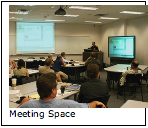EDTEC 700: Learning Spaces: Design Matters
Tops & Flops
Introduction
For this assignment, I assumed the perspective of a student with a hearing challenge. This is actually not far off, as I have directional hearing problems if there is too much white noise (probably from years of flying helicopters). So for my perspective, I don’t have a complete hearing loss, but need to rely on assistive aids, lip reading, and American Sign Language.
Tops
Through this exercise, I discovered some common factors for the “good” rooms.
- Smaller rooms
- Horseshoe, round-table, or wraparound layout
- Carpeted floors
- Walls and windows covered with cloth
- Lower ceilings
- Room with a central focus
The following three rooms earned my TOP seal of approval.
 Prospective Student Center
Prospective Student Center
As an auditory impaired learner, I think this is the best room yet. The room has a nice visual appeal, with muted colors and posters on the walls, and complementary carpet and seating colors. I especially appreciate the choice of materials such as wood and velvet, which provide good sound dampening. The large screen and integrated speaker system help make this setting much more accessible. The large seats give plenty of room to spread out with assistive devices.
 Roundtables
Roundtables
I like this layout. I can see the screens to read the material, and also see each participant's face for lip reading. The room is carpeted, and small enough to keep echoes to a minimum. The window treatments and corrugated chairs also help dampen any non-directional noise.
 Lecture Hall
Lecture Hall
This is a nice setting. I like that I can be discrete with my assistive devices while still being able to see both the displays and all my classmates. The carpet is nice, and the cushy seats and wooden tables help dampen some of the noise. The tiered arrangement and low ceiling combine to concentrate sounds in the center, which is a benefit for microphone pickups.
Flops
Some factors were universally bad from my perspective.
- Larger rooms
- Long rows of tables at 90 degrees to the ‘front’
- Tiled floors
- Bare walls and uncovered windows
- High ceilings
- Rooms with multiple boards and focus points
These three rooms were undoubtedly the biggest FLOPs.
 Lecture Hall
Lecture Hall
For me, this room has some challenges. The designers tried hard to minimize echoes, but near the back the rebroadcast audio comes through with some static. It would be nice if more of the seats had access to power, or had audio feeds built in. The clickers at every seat are nice, but if the instructor presents a question verbally I sometimes miss it.
 Meeting Space
Meeting Space
In this space, I wish I'd come earlier to get a seat in front. The displays are distracting because they divide my attention, and the little tables make all the side conversations hard to follow. Those florescent lights are making my headset buzz uncontrollably - time to buy a $400 upgrade with a shielded audio section.

Media and Study Lab
As an auditory impaired learner, I hate to see the exposed air return vents. When they rattle they really overpower the microphone of my assistive device. The tile floor amplifies every little sound from movement of the rolling chairs. When I study in here, I just turn my volume down.
(or, download 1.8mb .doc)